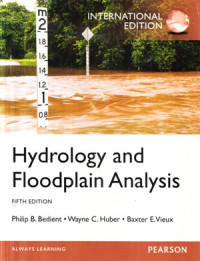Text
Hydrology and floodplain analysis
The field of hydrology is of fundamental importance to civil and environ-mental engineers, hydrogeologists, and other earth scientists because of the environmental significance of water supply, major floods and droughts and their management, drainage and urban stormwater issues, floodplain man¬agement, and water quality impacts. In recent years, hurricanes and storm surge have caused significant urban disasters, especially along coastal areas where urban development has expanded rapidly. This text was written to address the computational emphasis of modern hydrology at an undergrad¬uate or graduate level, and to provide a balanced approach to important applications in hydrologic engineering and science.
Increasing use and sophistication of personal computers has revolutionized the daily practice of hydrology. The Internet has revolutionized the accessibil¬ity of hydrologic data and computer models. The impact of transferring online data from governmental and scientific sources to the practicing hydrologist or student has been phenomenal. Hydrologic data, digital terrain models, and mapping software linked with hydrologic modeling have allowed complex problems to be solved. Geographical information systems (GIS) and radar rainfall have greatly improved our ability to predict hydrologic response using distributed information. A number of major improvements have been made to existing hydrologic models, such as HEC and SWMM, and advances in distributed hydrologic modeling such as Vflo. A list of important websites and links currently used routinely in hydrology is contained in Appendix E and can be found at the textbook website: hydrology.rice.edu.
Ketersediaan
Informasi Detail
- Judul Seri
-
-
- No. Panggil
-
627.4 Bed h
- Penerbit
- London : Pearson., 2013
- Deskripsi Fisik
-
816 hal. : il. ; 23 cm.
- Bahasa
-
English
- ISBN/ISSN
-
9780273774273
- Klasifikasi
-
627.4
- Tipe Isi
-
-
- Tipe Media
-
-
- Tipe Pembawa
-
-
- Edisi
-
Ed. V
- Subjek
- Info Detail Spesifik
-
-
- Pernyataan Tanggungjawab
-
-
Versi lain/terkait
Tidak tersedia versi lain
Lampiran Berkas
Komentar
Anda harus masuk sebelum memberikan komentar

 Karya Umum
Karya Umum  Filsafat
Filsafat  Agama
Agama  Ilmu-ilmu Sosial
Ilmu-ilmu Sosial  Bahasa
Bahasa  Ilmu-ilmu Murni
Ilmu-ilmu Murni  Ilmu-ilmu Terapan
Ilmu-ilmu Terapan  Kesenian, Hiburan, dan Olahraga
Kesenian, Hiburan, dan Olahraga  Kesusastraan
Kesusastraan  Geografi dan Sejarah
Geografi dan Sejarah